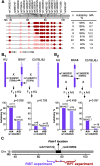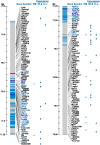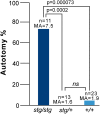Susceptibility to chronic pain following nerve injury is genetically affected by CACNG2
- PMID: 20688780
- PMCID: PMC2928496
- DOI: 10.1101/gr.104976.110
Susceptibility to chronic pain following nerve injury is genetically affected by CACNG2
Abstract
Chronic neuropathic pain is affected by specifics of the precipitating neural pathology, psychosocial factors, and by genetic predisposition. Little is known about the identity of predisposing genes. Using an integrative approach, we discovered that CACNG2 significantly affects susceptibility to chronic pain following nerve injury. CACNG2 encodes for stargazin, a protein intimately involved in the trafficking of glutamatergic AMPA receptors. The protein might also be a Ca(2+) channel subunit. CACNG2 has previously been implicated in epilepsy. Initially, using two fine-mapping strategies in a mouse model (recombinant progeny testing [RPT] and recombinant inbred segregation test [RIST]), we mapped a pain-related quantitative trait locus (QTL) (Pain1) into a 4.2-Mb interval on chromosome 15. This interval includes 155 genes. Subsequently, bioinformatics and whole-genome microarray expression analysis were used to narrow the list of candidates and ultimately to pinpoint Cacng2 as a likely candidate. Analysis of stargazer mice, a Cacng2 hypomorphic mutant, provided electrophysiological and behavioral evidence for the gene's functional role in pain processing. Finally, we showed that human CACNG2 polymorphisms are associated with chronic pain in a cohort of cancer patients who underwent breast surgery. Our findings provide novel information on the genetic basis of neuropathic pain and new insights into pain physiology that may ultimately enable better treatments.
Figures






References
-
- Bats C, Groc L, Choquet D 2007. The interaction between Stargazin and PSD-95 regulates AMPA receptor surface trafficking. Neuron 53: 719–734 - PubMed
-
- Bjorkman B, Arner S, Hyden LC 2008. Phantom breast and other syndromes after mastectomy: Eight breast cancer patients describe their experiences over time: A 2-year follow-up study. J Pain 9: 1018–1025 - PubMed
-
- Bouhassira D, Lanteri-Minet M, Attal N, Laurent B, Touboul C 2008. Prevalence of chronic pain with neuropathic characteristics in the general population. Pain 136: 380–387 - PubMed
-
- Breivik H, Collett B, Ventafridda V, Cohen R, Gallacher D 2006. Survey of chronic pain in Europe: Prevalence, impact on daily life, and treatment. Eur J Pain 10: 287–333 - PubMed
Publication types
MeSH terms
Substances
LinkOut - more resources
Full Text Sources
Other Literature Sources
Medical
Molecular Biology Databases
Miscellaneous
